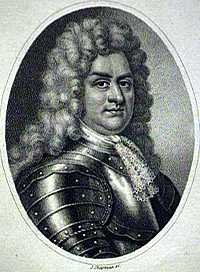Godert de Ginkell, 1st Earl of Athlone
| Godard van Reede | |
|---|---|
| Earl of Athlone | |

1st Earl of Athlone
|
|
| Born | 14 June 1644 Amerongen |
| Died | 11 February 1703 (aged 58) Utrecht |
| Occupation | General |
Godard van Reede, 1st Earl of Athlone, Baron of Aughrim, Lord of Ginkel, born in the Netherlands as Baron Godard van Reede (Amerongen, 14 June 1644 – 11 February 1703, Utrecht) was a Dutch general in the service of England.
He was born into a noble family as Baron van Reede, being the eldest son of Godard Adrian van Reede, Baron van Amerongen. In his youth he entered the Dutch cavalry as an officer, receiving his first commission at age 12. In 1688, he accompanied William, Prince of Orange, in his expedition to England — the "Glorious Revolution" which deposed James II. The following year, Ginkell distinguished himself by a memorable exploit—the pursuit, defeat and capture of a Scottish regiment that had mutinied for James at Ipswich, and was marching northward across the fens. It was the alarm excited by this mutiny that facilitated the passing of the first Mutiny Act. In 1690, Ginkell accompanied William III to Ireland to take on the Franco-Irish Jacobites, and commanded a body of Dutch cavalry at the Battle of the Boyne. On the King's return to England, General Ginkell was entrusted with the conduct of the war in Ireland. (See also Williamite war in Ireland).
He took command in Ireland in the spring of 1691, and established his headquarters at Mullingar. Among those who held a command under him was the Marquis of Ruvigny, the recognized chief of the Huguenot refugees. Early in June, Ginkell took the fortress of Ballymore, capturing the whole garrison of 1,000 men. The English lost only eight men. After reconstructing the fortifications of Ballymore, the army marched to Athlone, then one of the most important of the fortified towns of Ireland and key to the Jacobite defensive position, as it bridged the River Shannon. The Irish defenders of the place were commanded by a distinguished French general, the Marquis de St Ruth. The firing began on 19 June, and on 30 June the town was stormed, the Irish army retreating towards Galway, and took up their next defensive position at Aughrim. Having strengthened the fortifications of Athlone and having left a garrison there, Ginkell led the English combined forces, on 8 July, westward in pursuit of the retreating army and met the Franco-Irish in formal battle on 12 July 1691 at Aughrim.
...
Wikipedia
